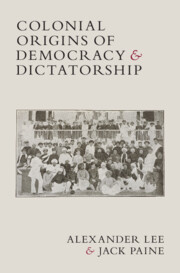Book contents
- Frontmatter
- Contents
- Figures
- Tables
- Acknowledgments
- 1 Introduction
- 2 A Theory of Colonial Electoral Institutions
- 3 Representation in Settler Colonies through 1850
- 4 Imperial Expansion and Restrictive Elections: 1850–1945
- 5 Mass Franchise Expansion after 1945
- 6 Postcolonial Persistence
- 7 Conclusion
- Appendix: Data and Regression Analysis
- References
- Index
5 - Mass Franchise Expansion after 1945
Published online by Cambridge University Press: 08 May 2024
- Frontmatter
- Contents
- Figures
- Tables
- Acknowledgments
- 1 Introduction
- 2 A Theory of Colonial Electoral Institutions
- 3 Representation in Settler Colonies through 1850
- 4 Imperial Expansion and Restrictive Elections: 1850–1945
- 5 Mass Franchise Expansion after 1945
- 6 Postcolonial Persistence
- 7 Conclusion
- Appendix: Data and Regression Analysis
- References
- Index
Summary
Prospects for successful mass revolts increased dramatically after 1945, but the pace of reform and approaches to decolonization varied. Some colonizers moved to mass-franchise elections and high autonomy, ending with formal independence – whereas others sought to cling to power. This yielded three main outcomes. (1) Franchise size and legislative autonomy expanded rapidly in most colonies ruled by democratic powers. These processes tended to occur earlier when left-wing governments were in power, who were less tied to the colonial project. (2) White settler elites and the governing class in authoritarian metropoles opposed empowerment for non-whites, who they perceived as an existential threat to their social status and economic rents. This prompted anticolonial revolts by disenfranchised Africans and Arabs. (3) Colonial officials sometimes granted autonomy to nonelectoral institutions if doing so would avoid revolt and be acceptable to metropolitan opinion. This desire led to a distinct type of authoritarian decolonization, prevalent among British colonies, in which the colonizer handed off power to a national monarch.
Keywords
- Type
- Chapter
- Information
- Colonial Origins of Democracy and Dictatorship , pp. 128 - 156Publisher: Cambridge University PressPrint publication year: 2024



